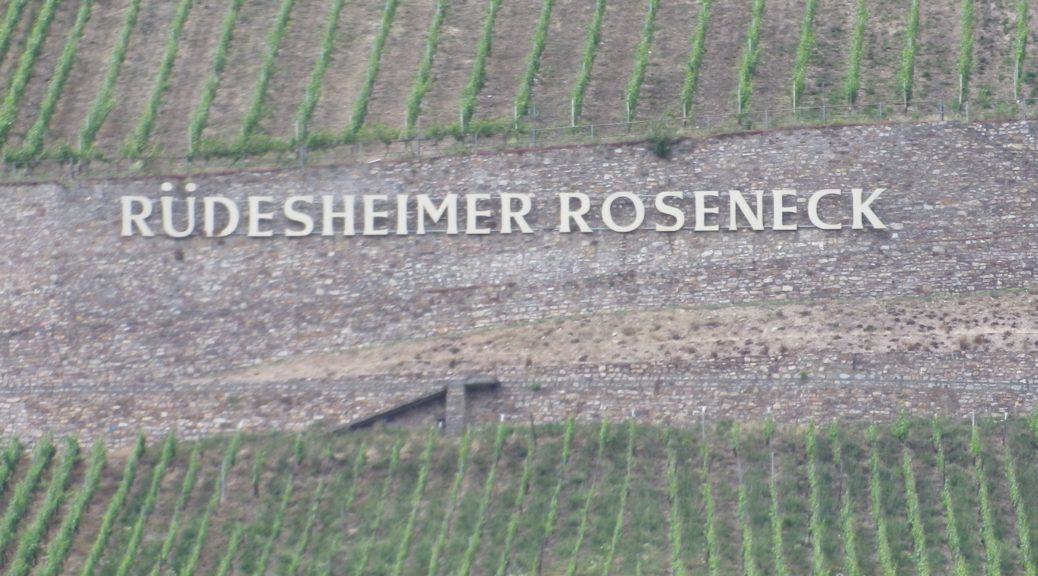What I Learned
According to many experts, Riesling wine reaches its pinnacle in the Rheingau. Here, the vintners have been making this wine, almost exclusively this wine, for hundreds of years. Locals as well as buyers from around the world eagerly await the resulting products each year. And from the modest-sized family wineries to the large international concerns, each winery will offer a range of Riesling wines, in styles ranging from dry to off-dry to sweet.
The most basic Riesling will be a Qualitaetswein. Next up the quality scale is a Kabinett Riesling.
Then you have the categories which highlight increasing grape ripeness. First comes the famous Spaetlese (late harvest) product. These wines are produced by harvesting some grape bunches a bit later than normal in the harvest season. They stay longer on the vine, and have an opportunity to ripen longer than average. The resulting wine is more substantial on the palate, and sweeter, although it can still be made in a dry style. The Auslese (select harvest) wines result from a careful selection of each bunch, and will be harvested even later in the season. For Beerenauslese (select berry harvest), harvesters will select grapes with some botrytis. Each berry is carefully separated from the bunch for inclusion in the harvest at that time. Trockenbeerenauslese (dry berry harvest) is another exacting harvesting practice. Harvesters select only those raisin-like berries which have actually dried on the vine. Upon vinification, only sweet wines result, and they can be very sweet indeed.
But Eiswein though, is in a class by itself. It is yet another painstaking harvest, and perhaps the most difficult. No botrytis may be on these grapes, and they must be perfectly whole. These are the grapes left on the vine until December, and harvested early in the morning while they are still frozen berries. only sweet wines result from this harvest, and they can be viscous, and intensely sweet. The name is easy to remember as Eiswein is pronounced not too differently than its English translation: Ice Wine.
Add to this Riesling wines products made from highly esteemed vineyard plots, or from old vines, you can see that any winery could have a number of different Riesling products on offer – and they can all be delicious!
What I Tasted
2016 Rheingau Riesling, Qualitaetswein, Feinherb, Weingut Mohr (Lorch): A dry white wine with medium gold color; turpentine and fruity nose, with ripe peach, spice and mineral flavors; medium acidity, with a sharp citrus finish.
2016 Rheingau Riesling, Spaetlese, Qualitaetswein, Weingut Mohr (Lorch): A dry white wine with medium minus gold color; slight turpentine and mineral nose, with honey and floral flavors; medium acidity.
2015 Riesling, Ruedesheimer Berg Roseneck, Trocken, Kabinett, Weingut Jakob Scholl Nachfolger (Ruedesheim): A dry white wine with light plus gold color; floral nose, with white floral, vanilla, and slight fruity flavors; tart, with a medium-length finish, medium acidity.
2015 Riesling, Ruedesheimer Kirchenpfad, Trocken, Kabinett, Weingut Adolf Stoerzel (Ruedesheim): A dry white wine with light gold color, a mineral, stony nose, with white stone fruits and slight floral and vanilla flavors; medium acidity, with a smooth, medium-length finish.
2015 Riesling, Ruedesheimer Drachenstein, Halbtrocken, Kabinett, Weingut K. Schaedel (Ruedesheim): An off-dry wine with light gold color; grassy nose, with citrus, apricot, and mango flavors, with a hint of spicy mustard; medium acidity with a smooth finish.
2014 Riesling, Trocken, QW, Weingut Prinz: A dry white wine with medium gold color; mineral nose with hints of chalk, and spicy mustard flavor; medium acidity.
2014 Riesling, Ruedesheimer Bishofsberg, Feinherb, Deutscher Qualitaetswein, Weingut Prasser (Ruedesheim): An off-dry white wine with light plus gold color; a floral and mango nose; with mango, spicy mustard and slight turpentine flavors; mild acidity with a long, smooth finish.
